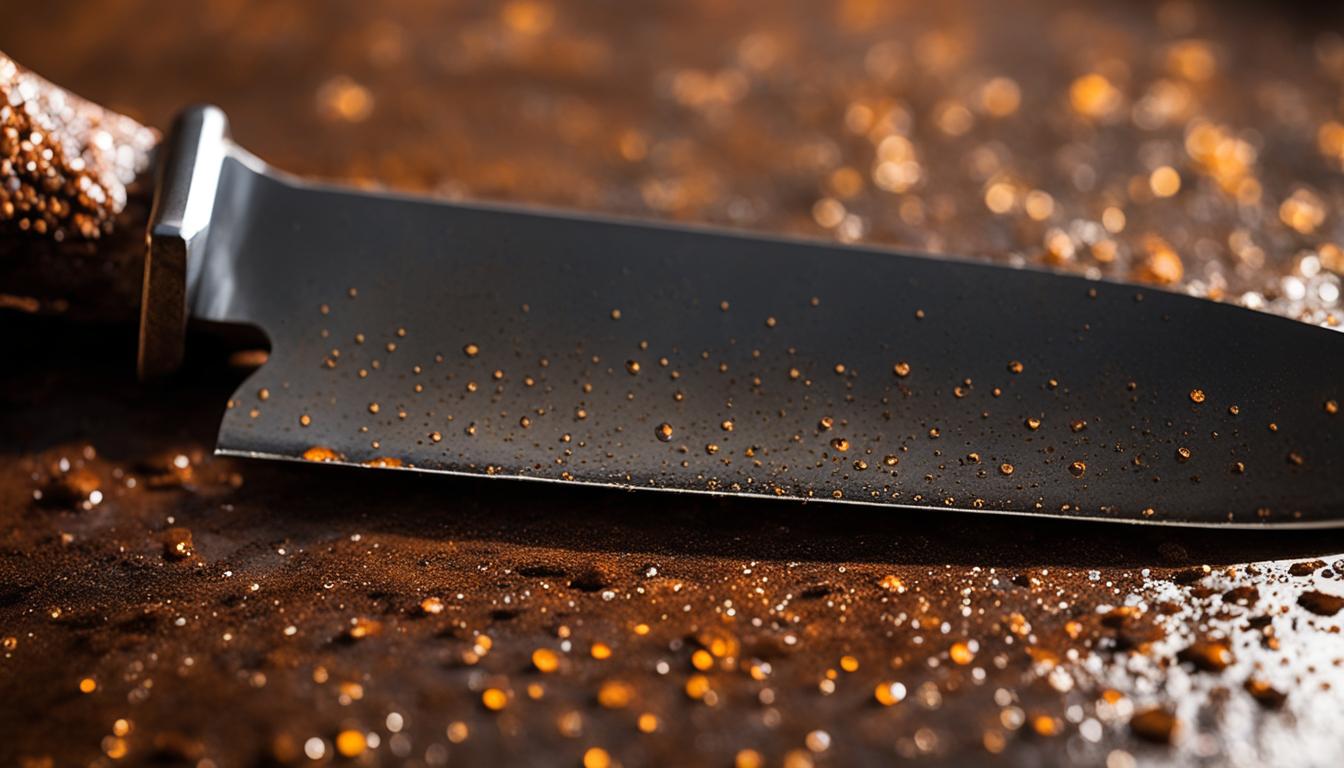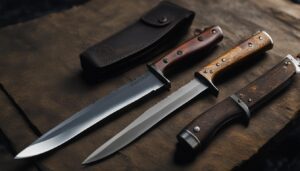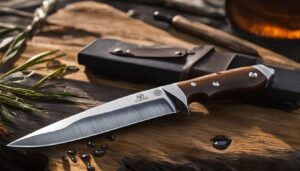Rust can be a problem for knife owners, especially in humid climates with high moisture content in the air. To prevent rust on steel blades, it is important to follow certain tips and practices consistently. Some things to avoid include storing a knife in a leather sheath, allowing the knife to get wet without taking preventive measures, and storing a dirty knife. On the other hand, it is important to routinely apply protective oil, clean the knife after use, and keep it dry. These simple habits can help prevent rust and keep the knife in excellent condition.
Key Takeaways:
- Proper storage practices, such as avoiding leather sheaths and keeping knives dry, can help prevent rust.
- Routine application of protective oil and regular cleaning are essential for rust prevention.
- Understanding the differences between rust and patina is important for maintaining the value of blades.
- Blade wax can provide an additional layer of protection against moisture and rust.
- Knowing when to seek professional help for restoration can prevent irreversible damage to valuable or delicate blades.
Why Steel Rusts and How to Protect Your Blades
Steel is a strong and durable material commonly used for making knife blades. However, it is prone to rust when exposed to oxygen and water. Understanding why steel rusts and taking preventive measures can help protect your blades and extend their lifespan.
Rust is a natural process that occurs when iron in steel reacts with oxygen and water. Both high carbon steel and stainless steel can rust, although stainless steel takes longer due to its higher resistance to corrosion. Rust can weaken the blade and cause pitting, which can affect its cutting performance.
To protect your knives from rust, it is important to distinguish between rust and patina. Patina is a yellowish color that develops on the surface of a carbon steel blade over time and can add character. It does not affect the blade’s performance and is often desired by knife enthusiasts.
There are several steps you can take to protect your blades from rust:
- Keep your knives clean and dry: After each use, clean the blade with soapy water and dry it thoroughly to remove any dirt, moisture, or acidic substances that can accelerate rust formation.
- Apply a protective coating: To strengthen the resistance to rust, some companies use processes like Parkerizing or Cerakote to apply a protective coating on the blade. However, regardless of the coating, routine cleaning and maintenance is still necessary.
- Store knives properly: Avoid storing knives in leather sheaths or in damp environments. Instead, use a moisture-resistant sheath or store them in a dry place with proper ventilation to prevent moisture buildup.
- Apply a rust-preventative oil: Regularly applying a thin layer of oil, such as mineral oil or gun oil, can create a barrier between the steel and moisture, helping to prevent rust formation.
By taking these preventive measures and maintaining regular care and maintenance, you can protect your blades from rust and ensure that they remain in optimal condition for years to come.
Cleaning and Maintenance Tips for Rust Prevention
Proper cleaning and maintenance are crucial for preventing rust on knives. Regular cleaning routines can help preserve the sharpness and longevity of the blades. After each use, it is important to clean the blade with soapy water and dry it thoroughly to remove any dirt or residue. This is especially important when using the knife in the kitchen, where acidic materials can contribute to rust formation.
Additionally, routine maintenance includes applying mineral oil to the joints and springs of a pocket knife to prevent moisture buildup. The entire blade should be wiped periodically with an oil-moistened cloth, particularly in hot and damp climates or near the ocean. It is also essential to clean not only the blade but also the handle, locking mechanisms, and pivot points if applicable, as dirt and other substances can contribute to rust formation.
By consistently following these cleaning and maintenance practices, knife owners can minimize the risk of rust and keep their blades in optimal condition. Regular care and attention will help ensure that knives remain functional, effective, and free from rust.
| Key Cleaning and Maintenance Tips for Rust Prevention |
|---|
| Clean the blade with soapy water after each use. |
| Dry the blade thoroughly to remove any moisture. |
| Apply mineral oil to the joints and springs of a pocket knife. |
| Wipe the blade periodically with an oil-moistened cloth. |
| Clean the handle, locking mechanisms, and pivot points. |
“Proper cleaning and maintenance are essential for preventing rust on knives.”
– Knife Care Expert
The Importance of Blade Wax for Rust Prevention
Rust can be a persistent problem for knife owners, but using blade wax is an effective way to prevent rust and keep your blades in excellent condition. Blade wax provides a protective barrier that helps to protect the steel from moisture and oxidation, minimizing the risk of rust formation. Not only does blade wax prevent rust, but it also offers several other benefits that contribute to the longevity of your knives.
One of the key benefits of blade wax is its ability to inhibit moisture penetration. When applied to a clean and dry blade, the wax fills in any microscopic imperfections or scratches on the surface, creating a barrier that prevents moisture from reaching the steel. This is particularly important when storing knives in humid environments or when they are exposed to moisture during outdoor activities.
Using blade wax is also a simple and practical way to maintain your knives. The wax creates a smooth surface that allows for easy cleaning, as dirt and debris are less likely to stick to the blade. Additionally, the wax provides a natural lubricant that helps to reduce friction and wear, extending the lifespan of the blade.
To use blade wax for rust prevention, start by thoroughly cleaning the knife to remove any dirt or residue. Apply a small amount of wax to a clean cloth and rub it onto the blade, covering all exposed surfaces. Make sure to reach all the nooks and crannies, including the handle and pivot points if applicable. After applying the wax, use a clean cloth to buff the blade, removing any excess wax and leaving behind a protective shine.
| Benefits of Blade Wax |
|---|
| Prevents rust formation |
| Inhibits moisture penetration |
| Creates a smooth surface for easy cleaning |
| Provides a natural lubricant to reduce friction and wear |
By incorporating blade wax into your knife maintenance routine, you can effectively prevent rust and keep your blades in optimal condition. Regularly applying blade wax helps to protect your knives from the damaging effects of moisture and oxidation, ensuring their longevity and performance.
Quote:
“Blade wax is a game-changer for rust prevention. It not only keeps my knives looking shiny and new, but it also gives me peace of mind knowing that they are protected from rust and corrosion.” – John K., avid knife collector
Key Steps for Rust Removal and Restoration
When it comes to dealing with rust on a blade, it is important to understand the key steps for successful rust removal and restoration. Preserving the blade’s patina while effectively removing rust requires careful attention to detail and the use of appropriate techniques. By following these steps, you can restore old blades and bring them back to their former glory.
Step 1: Assess the Damage
The first step in the rust removal process is to assess the extent of the damage. Take a close look at the blade, identifying any areas that are affected by rust. Determine whether the rust is superficial or has caused pitting or corrosion. This assessment will help you determine the appropriate course of action for restoration.
Step 2: Clean the Blade
Before attempting any rust removal, it is crucial to thoroughly clean the blade. Use a mild soap and water solution to remove any dirt or debris from the surface. Gently scrub the blade with a soft-bristled brush, being careful not to further damage the metal. Rinse the blade thoroughly and dry it completely to prevent further rust formation.
Step 3: Choose the Right Rust Removal Method
There are various methods for rust removal, and the appropriate approach will depend on the extent of the rust and the type of blade. For light surface rust, you can use a gentle abrasive like pencil lead or a rust eraser to gently remove the rust. For more stubborn rust or deep pitting, you may need to use steel wool or automotive sandpaper. Be cautious when using abrasive methods to avoid removing the blade’s patina.
| Rust Removal Methods | Pros | Cons |
|---|---|---|
| Pencil Lead | Non-abrasive, gentle on patina | May not be effective for heavy rust |
| Rust Eraser | Effective for light rust | May remove some patina |
| Steel Wool | Can remove stubborn rust | Can scratch the blade if not used carefully |
| Automotive Sandpaper | Effective for deep pitting | May remove significant patina |
Remember to take your time and proceed with caution when using any rust removal method. It is always better to start with the gentlest method and gradually increase the intensity if necessary. This will help minimize the risk of damaging the blade or removing valuable patina.
By following these key steps for rust removal and restoration, you can bring your old blades back to life. Remember to assess the damage, clean the blade thoroughly, and choose the appropriate rust removal method based on the extent of the rust and the type of blade. With proper care and attention, your knives can be restored to their former glory.
When to Seek Professional Help for Restoration
While many rust removal and restoration techniques can be done at home, there are instances when it is necessary to seek professional help. Professional knife restoration services offer expertise and specialized tools to ensure the best possible outcome for valuable or delicate blades. Here are a few scenarios where seeking professional help is recommended:
- If the blade has historical or personal significance, it is crucial to consult a restoration expert. They have the knowledge to handle unique blades with care and preserve their authenticity.
- When dealing with complex restoration cases or potential damage, professionals can provide guidance on the best course of action. Their experience and expertise can prevent irreparable harm to the blade.
- Professionals can also offer advice on the appropriate restoration techniques for different types of blades and materials. This ensures that the restoration process is tailored to the specific needs of the knife.
By entrusting your knife to a blade restoration expert, you can have peace of mind knowing that your prized possession is in capable hands. They can restore the blade’s functionality and condition, while also preserving its value and historical significance.
Restoration Services: Blade Restoration Experts
When it comes to professional knife restoration, it is important to choose a reputable service that specializes in blade restoration. Look for experts who have a proven track record in handling a wide range of blades and materials. They should have the necessary tools, knowledge, and experience to restore your knife to its former glory.
Blade restoration experts understand the intricacies of different blade types, whether it’s a hunting knife, kitchen knife, or collectible blade. They can assess the condition of the blade, identify the best restoration techniques, and execute them with precision. Through their expertise, they can remove rust, repair damage, and bring back the blade’s original luster.
When seeking professional help for restoration, be sure to research and choose a trusted service that has positive customer reviews and a strong reputation in the industry. By entrusting your knife to the hands of blade restoration experts, you can ensure that your treasured blade receives the care and attention it deserves.
Conclusion
I hope you found these knife rust prevention tips helpful in maintaining the sharpness and longevity of your blades. By implementing these simple practices, you can ensure that your knives stay rust-free and ready for use whenever you need them.
Remember, keeping your knife dry is one of the most important steps in preventing rust. After each use, make sure to clean the blade thoroughly and apply a protective oil to keep it in excellent condition. Regular maintenance and cleaning are key to keeping your knife sharp and rust-free.
Additionally, understanding the difference between rust and patina can help you appreciate the unique character and value that a well-used blade can acquire over time. If you ever need to restore your knife, consider seeking professional help to avoid any potential damage.
With proper care and attention, your knives can last a lifetime. So, take the time to maintain them, and they will continue to serve you well for years to come.
FAQ
Why is rust a problem for knife owners?
Rust can damage the blade and affect the knife’s performance. It is especially problematic in humid climates with high moisture content in the air.
How can I prevent rust on steel blades?
To prevent rust, avoid storing a knife in a leather sheath, exposing it to water without protection, or storing a dirty knife. Instead, regularly apply protective oil, clean the knife after use, and keep it dry.
Can stainless steel knives rust?
Yes, both high carbon steel and stainless steel knives can rust. Although stainless steel takes longer to rust, it is still susceptible over time.
What is the difference between rust and patina?
Rust is the result of iron in steel reacting with oxygen and water, while patina is a yellowish color that develops on the surface of a carbon steel blade. Patina can add character to a blade.
How should I clean and maintain my knife to prevent rust?
After each use, clean the blade with soapy water and dry it thoroughly. Apply mineral oil to the joints and springs of a pocket knife, wipe the entire blade with an oil-moistened cloth, and clean the handle, locking mechanisms, and pivot points if applicable.
What is blade wax and how can it prevent rust?
Blade wax, such as Renaissance Wax or RenWax, can be applied to the clean and dry blade to protect it from moisture and prevent rust. It also helps seal any scratches in the blade’s coating.
How do I remove rust from a blade?
Depending on the level of rust, you can use techniques like using pencil lead or mild abrasives like Flitz or Simichrome. More abrasive methods include rust erasers, steel wool, or automotive sandpaper.
Should I seek professional help for blade restoration?
If a blade has historical or personal significance, it is wise to consult a restoration professional to avoid irreparable damage. They have the expertise to handle valuable or delicate blades and offer expert advice on restoration.





